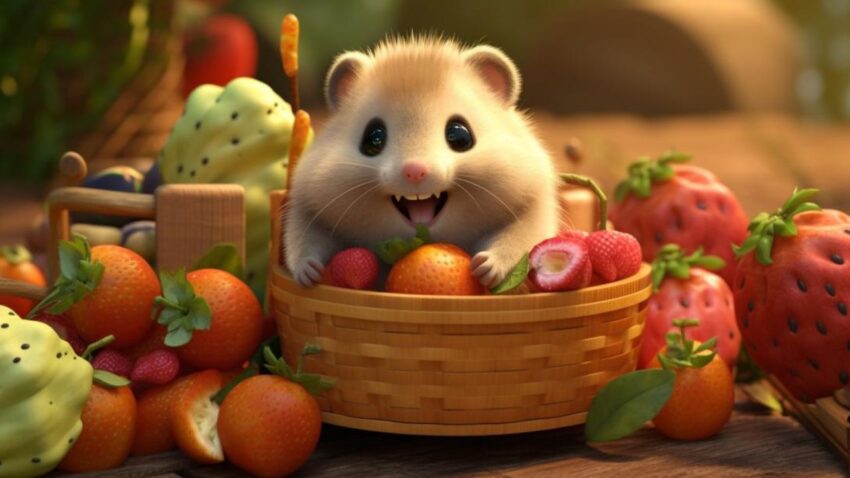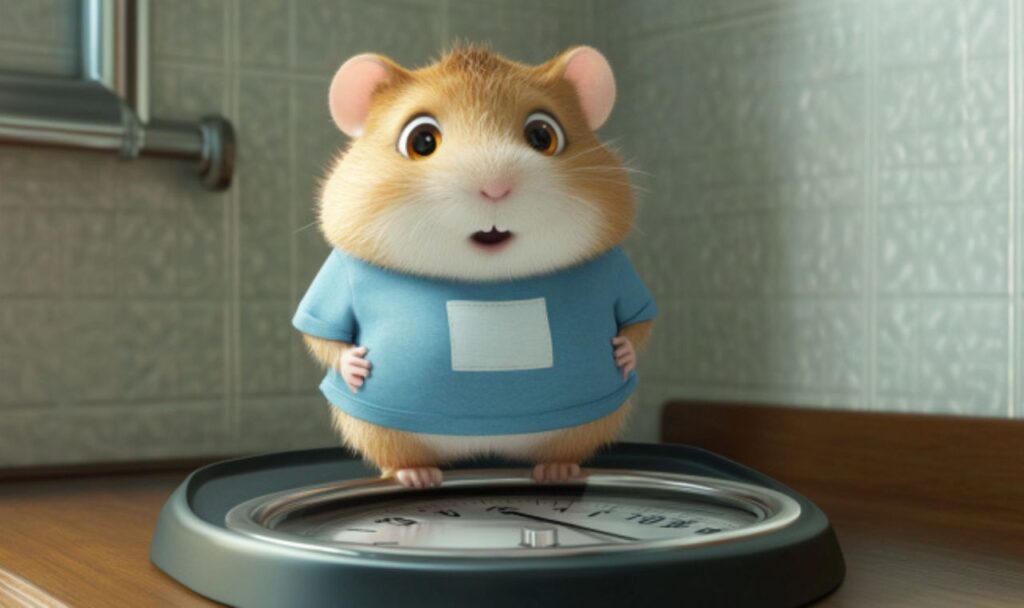Hello, my dear hamster parents! It’s your devoted Granny SnuggleSnacks here, ready to share some of my coziest wisdom on training our fluffy little friends. In my many years of loving and caring for these adorable creatures, I’ve learned a thing or two about what makes them tick, especially when it comes to training. So, grab a cup of herbal tea, and let’s dive into the delightful world of hamster training with some healthy and scrumptious treats!
Granny SnuggleSnacks’ Approach to Hamster Training
Training a hamster, my lovelies, is much like knitting a delicate sweater – it requires patience, gentleness, and a whole lot of love. In my quaint little kitchen, where I’ve spent countless hours preparing tiny feasts for my furry family, I’ve always believed that training should be a joyful and bonding experience. It’s not just about teaching tricks; it’s about understanding and communicating with these tiny beings, nurturing a deep and trusting relationship. My approach combines simple, positive reinforcement techniques with a selection of wholesome treats. This method not only encourages good behavior but also ensures that our hamsters stay healthy and happy.
The Importance of Choosing Healthy Treats
Now, when it comes to selecting treats for training, I can’t stress enough the importance of choosing healthy options. You see, hamsters are like us – their wellbeing is deeply impacted by what they eat. Their tiny bodies need a balanced diet, rich in nutrients, to stay vigorous and spry. Unhealthy treats, or too much of a good thing, can lead to weight gain, nutritional imbalances, and health issues. That’s why I always opt for natural, fresh, and nutrient-packed goodies. These treats not only motivate our furry friends during training sessions but also contribute to their overall health. Think of it as giving them a hug with every little bite!
How Treats Can Enhance Training Effectiveness
Incorporating treats into training sessions, my darlings, is like sprinkling a bit of magic into the process. Treats are powerful motivators for hamsters. When they know a delicious reward awaits, they’re more eager to participate and learn. It’s essential, however, to strike a balance. The treats should be enticing enough to hold their interest, but not so large or frequent that they lose their appeal or nutritional value. By using treats effectively, we can enhance the training experience, making it more enjoyable and successful for both the hamster and the trainer. It’s about creating positive associations – with each little nibble, your hamster not only learns a new trick but also feels loved and cherished.
And so, my dear friends, as we venture into the world of hamster training with these wholesome treats, remember, it’s not just about the end result – it’s about the journey, the bond you build, and the love you share.
Apple Slices: A Sweet Training Tool
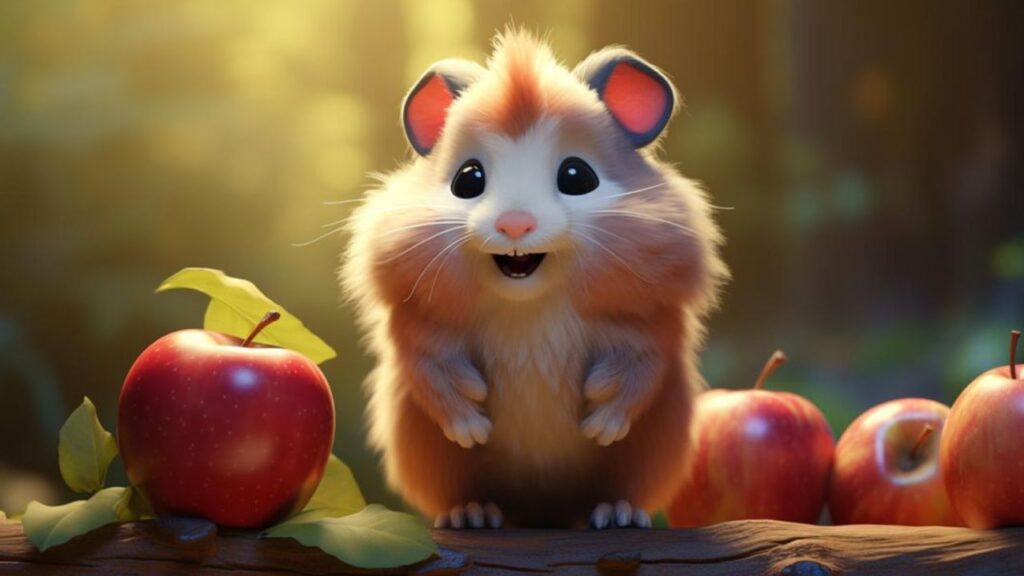
Ah, apples! These crisp, juicy fruits have always been a staple in my pantry, and for good reason. Not only are they delicious and versatile for us humans, but they also make fantastic treats for our hamster friends during training sessions. Let’s explore why these sweet morsels are a great choice, how to prepare them safely, and how to use them effectively in training our furry companions.
Why Apples are Great for Hamsters
Firstly, my dear hamster enthusiasts, let’s talk about why apples are a wonderful treat for our little pals. Apples are a natural source of fiber, which is essential for a hamster’s digestive health. They also contain vitamin C and various antioxidants, supporting overall well-being. However, it’s important to remember that apples, like all treats, should be given in moderation. Their sugar content, while natural, can be high for a hamster’s tiny body if overfed. A little slice of apple can be a delightful reward, offering both nutritional benefits and a burst of sweet flavor that most hamsters find irresistible.
How to Safely Prepare Apple Slices
Now, preparing apple slices for your hamster is as simple as pie, but there are a few key things to remember. First, always choose organic apples when possible, to avoid harmful pesticides. Wash the apple thoroughly, my dears, to ensure it’s clean and safe. Remove the skin as it can be tough for hamsters to digest. Also, be sure to take out all the seeds, as they contain small amounts of a compound that can be toxic to hamsters. Once the apple is prepared, cut it into tiny, bite-sized pieces – just right for those little paws to handle. Remember, we’re aiming for a nibble, not a feast!
Incorporating Apple Slices into Training
Incorporating apple slices into training sessions is a delightful way to enhance the learning experience for your hamster. Use these tiny pieces as rewards for positive behavior or successful completion of a trick. For instance, when your hamster successfully navigates through a little maze or comes to you when called, reward them with a piece of apple. It’s important to balance the use of treats with regular meals, so adjust their daily food intake accordingly. Also, observe how your hamster reacts to apples; each little one has its own preferences and dietary needs.
By using apple slices as a training tool, we’re not just teaching tricks; we’re also providing a healthy snack and creating an enjoyable experience for our hamsters. It’s a sweet way to build trust and strengthen the bond between you and your furry friend.
Blueberries: Tiny and Nutritious Rewards
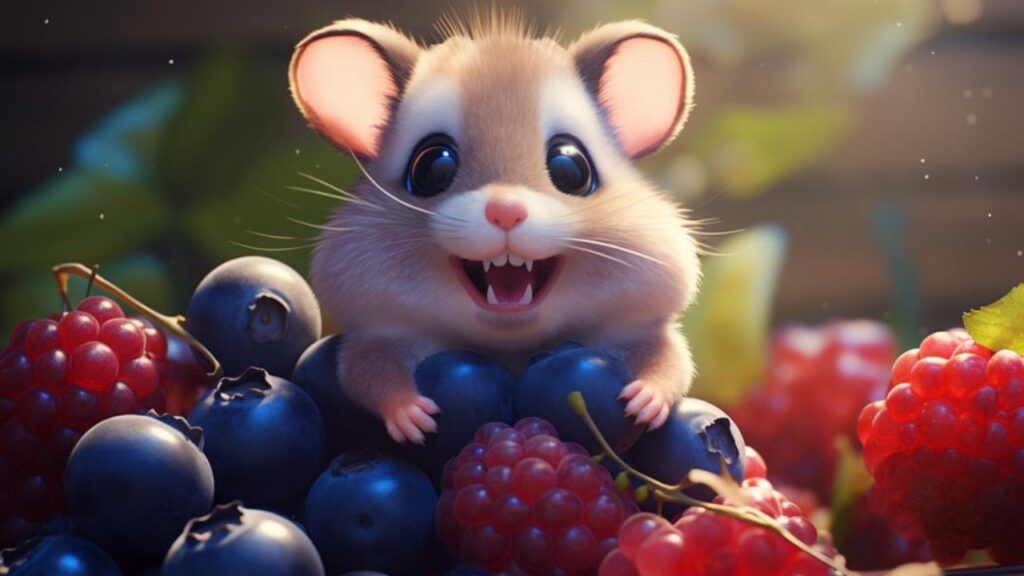
Ah, blueberries – nature’s little sapphires! These tiny, delectable fruits have always been a favorite in my garden, and they’re just as beloved by our hamster friends. Blueberries are not only a tasty treat but also packed with nutrients that are excellent for your hamster’s health. Let’s explore the benefits of these little berries, how to serve them properly, and how to incorporate them into your training sessions.
Health Benefits of Blueberries for Hamsters
Blueberries are a powerhouse of nutrition, especially suitable for our tiny companions. They are rich in vitamins C and K, providing essential nutrients that support the immune system and overall health of your hamster. These berries are also loaded with antioxidants, which help fight free radicals and can reduce the risk of certain diseases. Additionally, blueberries have a high fiber content, which is crucial for maintaining a healthy digestive system in hamsters. However, just like with apples, moderation is key. Due to their sugar content, blueberries should be given as a treat, not a staple in their diet.
Serving Blueberries to Your Hamster
When it comes to serving blueberries to your hamster, there are a few simple guidelines to follow. Firstly, always choose fresh, organic blueberries to ensure they are free from pesticides. Give them a good wash to clean off any dirt or residues. Since hamsters are small, you’ll want to serve blueberries in moderation – one or two at a time is plenty. You can offer them whole, as their small size is generally manageable for a hamster to nibble on. However, for smaller or younger hamsters, you might consider cutting the berry in half to make it easier to eat.
Using Blueberries in Training Sessions
Blueberries can be an excellent reward during training sessions due to their small size and appealing taste. They can be used to reinforce positive behaviors or to encourage your hamster to complete a task, like running through a tunnel or mastering a new trick. The key is to use them as a special treat – something that your hamster looks forward to during training. This helps in maintaining their interest and focus during the session. Remember, the goal is to reward the behavior immediately, so keep those blueberries handy while training!
Incorporating blueberries as a training reward offers not just a tasty snack for your hamster, but also contributes to their health. It’s a delightful way to make training sessions more engaging and enjoyable for your little furball.
Small Carrot Pieces: Crunchy and Healthy

Oh, the humble carrot – a garden favorite that’s as nutritious as it is delicious! These crunchy vegetables are not just for us humans; they make excellent treats for our hamster friends too. Carrots are packed with essential nutrients and can add a bit of fun and variety to your hamster’s diet. Let’s nibble our way through the benefits of carrots, learn how to prepare them safely, and use them to add some crunch to our training sessions.
The Nutritional Value of Carrots
Carrots are a wonderful source of vitamins, particularly Vitamin A, which is vital for maintaining good eye health and a strong immune system. They are also rich in fiber, which aids in digestion, and antioxidants, which help protect the body from harmful free radicals. Additionally, carrots have a high water content, making them a hydrating snack. However, like all good things, carrots should be given in moderation due to their natural sugars. A small piece of carrot can be a nutritious and enjoyable treat for your hamster, providing both a tasty snack and essential nutrients.
Preparing Carrot Pieces for Safe Consumption
When preparing carrots for your hamster, there are a few simple steps to ensure they are safe and enjoyable. First, choose organic carrots if possible, to avoid pesticide residue. Wash the carrot thoroughly to remove any dirt or chemicals. Peel the carrot to eliminate any tough skin that could be difficult for your hamster to digest. Then, cut the carrot into small, manageable pieces – think tiny cubes or thin slices that your hamster can easily handle. It’s important to remember that these pieces are treats, so they should be small enough to be enjoyed in moderation.
Making Training Fun with Carrots
Carrots can be a fantastic addition to your hamster training routine. Their bright color and crunchy texture make them an attractive and exciting reward for your furry friend. You can use small pieces of carrot to encourage your hamster to complete a task or learn a new trick. For instance, guide your hamster through a homemade obstacle course with carrot pieces as checkpoints. Or reward them with a tiny carrot slice after they successfully follow a command or complete a puzzle. This not only motivates your hamster but also makes training a fun and interactive experience.
By incorporating carrots into your training sessions, you’re providing your hamster with a healthy snack and an engaging activity. It’s a wonderful way to bond with your pet and keep them both mentally and physically stimulated.
Cooked Brown Rice: A Gentle Treat

Ah, brown rice – a simple yet splendid grain that often graces my kitchen for family meals. But did you know, my dear hamster parents, that this wholesome grain can also be a gentle and nutritious treat for our little hamster friends? Yes, indeed! Cooked brown rice, in moderation, can be a delightful addition to your hamster’s diet and a useful tool in training. Let’s delve into why brown rice is a good choice, how to prepare it for tiny paws, and how to integrate it into your training routines.
Why Brown Rice is a Good Choice
Brown rice is a whole grain, which means it retains its natural nutrients, unlike its more processed cousin, white rice. It’s a good source of carbohydrates, providing energy for your hamster’s active lifestyle. Brown rice also contains fiber, which aids in digestion, and various vitamins and minerals. It’s a low-fat, gentle option that’s easier on your hamster’s delicate digestive system compared to richer or more sugary treats. However, as always with hamster treats, moderation is key – brown rice should be a small part of your hamster’s diet, complementing their regular, nutritionally balanced meals.
Preparing and Serving Brown Rice
Preparing brown rice for your hamster is a straightforward affair. First, cook the rice without any added salt, sugar, or seasonings – plain is best for these little ones. Ensure the rice is cooked thoroughly until it’s soft, as undercooked rice can be hard to digest for hamsters. Once cooked, let the rice cool completely before serving. It’s important to serve brown rice in very small quantities. A few grains are enough for a hamster – remember, their stomachs are tiny! Leftover rice should be stored in the refrigerator and can be served over a couple of days, ensuring it’s always fresh and safe for consumption.
Integrating Brown Rice into Training Routines
Using cooked brown rice in your training routines offers a unique and healthy way to reward your hamster. Its mild flavor and soft texture make it a suitable treat for hamsters of all ages. You can use a tiny pinch of rice to reward your hamster for a job well done, whether it’s mastering a new trick or simply responding to their name. The small size of the rice grains makes it easy to manage portion control, ensuring you’re not overfeeding your furry trainee. Plus, the act of picking up and eating these tiny grains can be an engaging activity for your hamster, stimulating their mind as well as satisfying their taste buds.
Incorporating cooked brown rice into your hamster training sessions provides a simple yet effective reward that’s easy on their stomachs and beneficial for their overall health. It’s a lovely, understated way to show your love and care during those special bonding moments.
Fresh Cucumber Slices: Hydration and Health
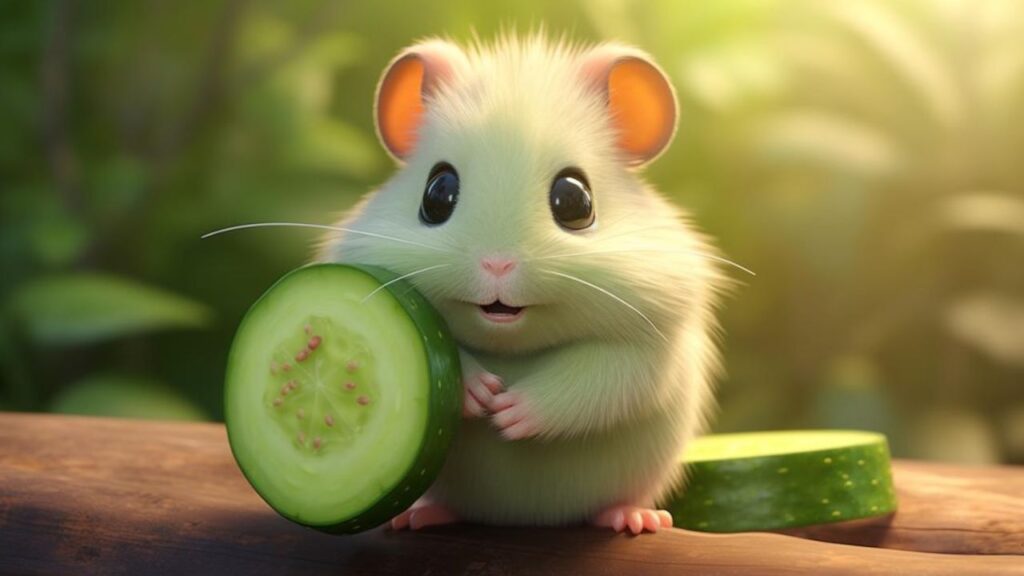
On a warm summer’s day in my garden, while I watch the bees buzzing and the flowers blooming, there’s nothing quite like a crisp cucumber from the vine. And just like us, our little hamster friends can enjoy the refreshing qualities of cucumbers too. These green goodies are not only hydrating but also a healthy snack option for hamsters. Let’s dive into the benefits of cucumbers, how to serve them safely, and how to use cucumber slices as rewarding treats in training sessions.
Cucumbers: A Source of Hydration
Cucumbers are made up mostly of water, which makes them an excellent snack for keeping your hamster hydrated, especially during warmer weather. Besides their high water content, cucumbers also offer a modest array of nutrients, including vitamin K, which is good for bone health, and a small amount of dietary fiber. They are low in calories and sugar, making them a safe and healthy choice for an occasional treat. However, due to their high water content, cucumbers should be given in moderation to avoid upsetting your hamster’s digestive system.
Safe Ways to Serve Cucumbers
When serving cucumbers to your hamster, it’s important to do so safely. Always start by selecting fresh, organic cucumbers to minimize exposure to pesticides. Wash the cucumber thoroughly under clean water. Peeling the cucumber is a good idea, as the skin can be tough for hamsters to digest and might contain traces of pesticides. Slice the cucumber into small, manageable pieces – a thin slice or a small cube is sufficient. Remember, cucumbers are a treat and should not replace your hamster’s regular, nutritionally balanced diet.
Cucumber Slices as Training Rewards
Cucumber slices can be a wonderful addition to your hamster’s training regimen. Their cool and refreshing taste can motivate your furry friend, especially on hot days. Use small pieces of cucumber as a reward for good behavior during training sessions. For example, when your hamster successfully navigates a new toy or learns a simple command, a tiny piece of cucumber can be a satisfying and hydrating prize. The key is to keep the treat small and occasional, ensuring it remains a special reward and doesn’t disrupt their regular eating habits.
Incorporating cucumber slices into your training sessions not only provides a healthy snack but also adds a bit of variety to the routine. It’s a delightful way to keep your hamster interested and engaged, all the while promoting good hydration and health.
Plain Cooked Chicken: Protein-Rich Bites

Now, let’s chat about a treat that might surprise you – plain cooked chicken. While our hamster friends are often associated with a diet of grains and veggies, a little bit of protein can be a healthy addition. Cooked chicken, served in moderation, can be a delightful and nutritious treat for your hamster. It’s a bit of a gourmet option in the hamster world, and one that can be particularly effective in training. Let’s explore the benefits, preparation methods, and how to use chicken as a high-value training treat.
The Benefits of Chicken for Hamsters
Chicken is a wonderful source of lean protein, which is essential for muscle growth and repair in hamsters. It also contains important vitamins and minerals such as B vitamins, which are crucial for a healthy nervous system and metabolism. Offering a small amount of cooked chicken as a treat can add valuable variety to your hamster’s diet and provide these essential nutrients. However, it’s crucial to remember that chicken should be given only as a treat, not as a regular part of the hamster’s diet, and always in small quantities.
How to Prepare Chicken for Hamsters
Preparing chicken for your hamster is straightforward but requires some care. First and foremost, the chicken should be cooked plainly – no salt, spices, garlic, onions, or oils, as these can be harmful to hamsters. Boiling or baking the chicken without any additives is the safest method. Once cooked, ensure the chicken is completely cooled before serving. Remove all bones, as they can be a choking hazard and may splinter, causing harm. Cut the chicken into tiny, bite-sized pieces, appropriate for your hamster’s small size. Any leftover chicken should be stored in the refrigerator and can be offered over a couple of days.
Using Chicken as a High-Value Training Treat
In the realm of hamster training, cooked chicken can be considered a high-value treat. Because it’s a bit of a rarity in their diet, it can be very effective in motivating your hamster during training sessions. Use tiny pieces of chicken as a reward for particularly challenging tasks or new tricks that your hamster masters. The novel flavor and texture of the chicken will capture your hamster’s interest and can make training sessions more exciting. Remember, the goal is to offer just enough to entice them without overfeeding.
Using plain cooked chicken as a training treat offers your hamster a delicious, protein-rich reward and can be a great way to enhance the training experience. It’s a little luxury that can go a long way in motivating and rewarding your furry friend for their hard work and achievements.
Hard-boiled Egg: A Protein Treat

When I think of a cozy breakfast on a sunny morning, a hard-boiled egg often comes to mind. But did you know, my dear hamster caregivers, that these simple eggs can also be a nutritious treat for our little furballs? Yes, indeed! A small portion of hard-boiled egg can be a wonderful source of protein and vitamins for hamsters. Let’s crack into the nutritional advantages of eggs, how to prepare them for our tiny friends, and how to use them as an occasional, high-value training reward.
Nutritional Advantages of Eggs
Eggs are packed with high-quality protein, essential for the growth and repair of tissues in your hamster. They also provide a range of vitamins and minerals, including Vitamin B12, riboflavin, and selenium, which are important for your hamster’s overall health. Additionally, eggs contain essential amino acids that hamsters need in their diet. But, as with any treat, eggs should be given in moderation. They are rich in nutrients, and overfeeding can lead to obesity and other health issues. A tiny piece of hard-boiled egg is a special treat, providing both a tasty change of pace and a boost of essential nutrients.
Preparing Eggs for Your Hamster
Preparing a hard-boiled egg for your hamster is quite simple, but there are a few key points to remember. Boil the egg until it’s thoroughly cooked – raw or undercooked eggs can contain harmful bacteria. Let the egg cool completely after boiling. Peel off the shell, as it’s not digestible for hamsters. Then, chop the egg into tiny, hamster-sized pieces. Remember, we’re only offering a little nibble – a small piece of egg is enough for a hamster. Any leftover egg should be stored in the refrigerator and offered within a day or two to ensure freshness.
Eggs as an Occasional Training Reward
Hard-boiled eggs can be an excellent occasional reward during hamster training sessions. Their unique taste and texture make them an enticing and high-value treat for most hamsters. Use these small pieces of egg to reward your hamster for a job well done, especially when they achieve a significant milestone or learn a challenging new trick. This not only motivates your hamster but also adds a valuable protein boost to their diet. It’s important, however, to keep this treat infrequent to maintain its special status and prevent any dietary imbalances.
Offering a hard-boiled egg as a treat during training sessions provides your hamster with a nutritious and exciting reward. It’s a delightful way to encourage and celebrate your hamster’s accomplishments, making your training sessions both enjoyable and beneficial.
Oats: A Wholesome Snack
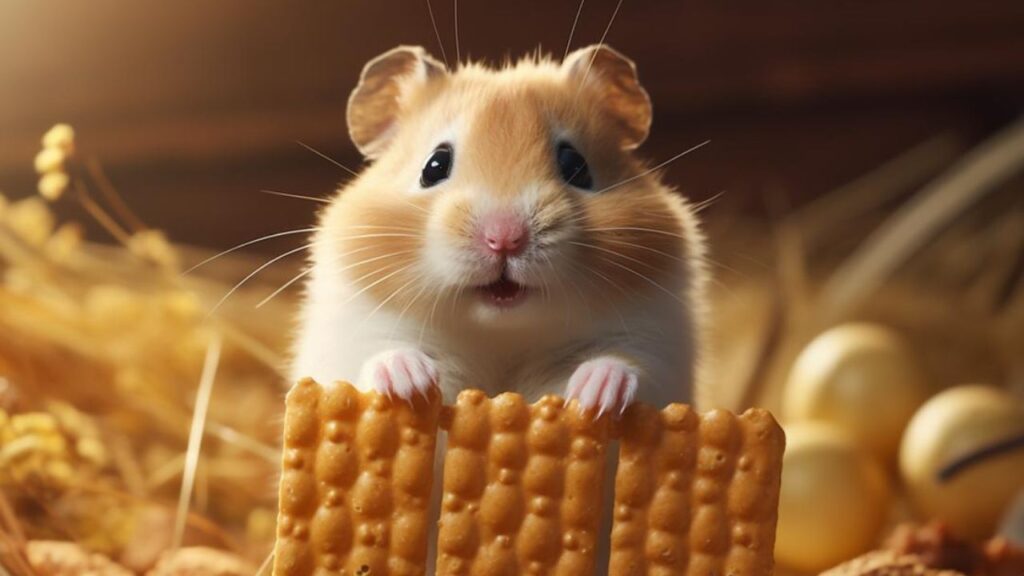
In the early mornings, as the sun peeks through my kitchen window, I often enjoy a warm bowl of oats. This simple, hearty grain isn’t just a staple for us humans; it can also be a wholesome snack for our furry hamster friends. Oats, when given properly, can offer health benefits and serve as a lovely treat during training sessions. Let’s delve into why oats are beneficial for hamsters, how to serve them, and the ways we can incorporate them into our hamster training activities.
Why Oats are Good for Hamsters
Oats are a fantastic source of nutrients that are beneficial for hamsters. They are rich in fiber, which aids in digestion and helps prevent constipation, a common issue in these little creatures. Oats also contain proteins, vitamins, and minerals such as magnesium, which can contribute to a healthy, balanced diet. They are a good source of energy, too, providing the stamina our active little friends need. However, it’s essential to offer oats in moderation as part of a balanced diet – too much can lead to weight gain and nutritional imbalances.
Serving Oats to Your Furry Friend
When serving oats to your hamster, opt for plain, unflavored, and unsweetened varieties. Instant or flavored oats often contain added sugars and chemicals that are not suitable for hamsters. You can offer them raw or cooked – both are fine, but ensure cooked oats are cooled completely before serving. If you choose to cook the oats, prepare them with water, not milk, as dairy can upset a hamster’s digestive system. Offer a small pinch of oats at a time – just enough for a tiny treat. Remember, the key is moderation to keep your hamster healthy and happy.
Using Oats in Training Activities
Oats can be a wonderful little reward during training activities with your hamster. Their small size and palatable nature make them ideal for reinforcing positive behaviors and achievements. You can use oats to encourage your hamster to complete a maze, learn a new trick, or simply as a reward for good behavior. Sprinkling a few oats at the end of a tunnel or near a new toy can also encourage exploration and play. Oats are especially useful for training because they are not too distracting or filling, allowing your hamster to stay focused on the task at hand.
Incorporating oats into your hamster’s training routine offers a healthy, low-fat treat option that is both nutritious and motivating. It’s a simple, yet effective way to enhance the bonding and learning experience with your furry companion.
Parsley: A Fresh and Healthy Herb

In my little herb garden, where the air is always filled with the scent of fresh greenery, parsley holds a special place. This fragrant herb isn’t just a garnish for our dishes; it can also be a delightful treat for our hamster friends. Parsley is not only flavorful but comes packed with health benefits for our tiny companions. Let’s explore the benefits of parsley for hamsters, how to include it in their diet safely, and ways to use it as a unique training treat.
The Health Benefits of Parsley
Parsley is a nutrient-dense herb that offers various health benefits for hamsters. It is rich in vitamin C, an essential nutrient that hamsters cannot produce on their own. Vitamin C is crucial for maintaining a healthy immune system and preventing scurvy, a common concern in these little pets. Parsley also contains vitamin K, which supports bone health, and antioxidants that help protect the body’s cells. Additionally, it has anti-inflammatory properties and can aid in digestion. However, like any treat, parsley should be given in moderation to avoid digestive issues or nutrient imbalances.
How to Include Parsley in Your Hamster’s Diet
Introducing parsley to your hamster’s diet is simple, but there are a few guidelines to follow. First, choose fresh, organic parsley to minimize exposure to pesticides. Wash the herb thoroughly under clean water to remove any dirt or potential residues. Chop the parsley finely to make it easy for your hamster to eat – large leaves can be overwhelming and difficult to manage. Offer a small amount of chopped parsley as a treat – a pinch is plenty for a hamster. Remember to introduce any new food gradually to monitor how your hamster reacts and ensure it doesn’t upset their stomach.
Parsley as a Unique Training Treat
Parsley can be a unique and enticing treat for hamsters during training sessions. Its strong aroma and fresh taste can capture your hamster’s interest, making it an excellent reward for successful behaviors or completed tasks. Use tiny bits of parsley to encourage your hamster to try new activities, learn tricks, or explore new parts of their habitat. It’s a wonderful way to add some variety to their training treats and keep them engaged and motivated. Plus, the process of nibbling on these small, leafy pieces can be both mentally stimulating and enjoyable for them.
Using parsley as a training treat offers a fresh, nutritious option to reward and bond with your hamster. It’s a delightful way to incorporate healthy greens into their diet while making training sessions fun and rewarding.
Dandelion Leaves: A Natural Delight

As I stroll through my garden, admiring the daisies and sunflowers, I often pause to appreciate the humble dandelion. Often dismissed as mere weeds, these resilient plants are, in fact, a storehouse of nutrients and a natural delight for our hamster friends. Dandelion leaves can be a healthful addition to a hamster’s diet, providing vitamins and a touch of the wild. Let’s delve into the world of dandelions, learn how to offer them safely, and use them in our training sessions.
Dandelions: Not Just Weeds
Dandelion leaves are much more than common garden weeds; they are packed with nutrition. These green leaves are a rich source of vitamins A, C, and K, and contain minerals like iron and calcium. They can aid in digestion and help support a healthy liver and kidney function in hamsters. Dandelions also have diuretic properties, promoting good urinary health. Their slightly bitter taste is often a hit with hamsters, offering a change from their usual sweet or bland treats. However, moderation is key, as too much can cause digestive upset.
Safe Ways to Offer Dandelion Leaves
When offering dandelion leaves to your hamster, it’s essential to do so safely. First, ensure that the dandelions are free from pesticides and other chemicals – this means avoiding dandelions from lawns or parks that may be treated with herbicides. It’s best to use dandelions that you’ve grown yourself or those from a trusted organic source. Wash the leaves thoroughly to remove any dirt or small insects. Chop the leaves into small, manageable pieces for your hamster to nibble on. Offer dandelion leaves as an occasional treat, not a regular part of their diet.
Incorporating Dandelions into Training
Dandelion leaves can be a wonderful addition to your hamster’s training routine. Their unique flavor can pique your hamster’s interest, making them an effective reward for learning new tricks or behaviors. You can use small pieces of dandelion leaves to encourage your hamster to explore new areas of their cage, navigate through mazes, or respond to simple commands. The act of foraging for these leaves can also provide mental stimulation, mimicking their natural behaviors in the wild. It’s a great way to enrich your hamster’s training experience with something both healthful and novel.
Using dandelion leaves as part of your training rewards system offers a natural, nutritious treat option. It adds variety to your hamster’s diet and brings a little piece of the wild into their lives, making training sessions both fun and beneficial.
Conclusion

As we come to the end of our delightful journey through the world of healthy hamster treats, let’s take a moment to reflect on the joys and benefits of training our furry companions. With a basket full of wholesome treats and a heart full of love, we’re not just teaching tricks – we’re nurturing a bond that’s as special as each little nibble.
Variety is the Spice of Life… and Training!
Just like us, hamsters enjoy a bit of variety in their lives. Offering different treats not only keeps training sessions interesting but also ensures a balanced intake of nutrients. Whether it’s the crunch of a carrot, the sweetness of an apple, or the novelty of a dandelion leaf, each treat brings its own unique flavor and health benefits. By rotating these treats, we can keep our hamsters excited about training and ensure they’re getting a spectrum of vitamins and minerals.
Observing Your Hamster’s Preferences and Reactions
Each hamster is an individual with its own likes and dislikes. While one may go gaga over a piece of cucumber, another might prefer the simplicity of oats. It’s important to observe how your hamster reacts to different treats. Some might be more motivating than others, and some may not agree with your hamster’s tummy. Paying attention to their preferences and reactions helps you tailor their training and diet to their specific needs, ensuring a happy and healthy pet.
The Bonding Power of Training with Treats
Training with treats is about more than just teaching behaviors; it’s a powerful way to bond with your hamster. Each training session is an opportunity to build trust and understanding. The treats are a symbol of the care and love you share, making each accomplishment a shared joy. Remember, the goal of training is to enhance your relationship and provide mental and physical stimulation for your hamster.
SnuggleTip
“Always observe your hamster’s reaction to new treats, and adjust their diet accordingly to maintain a balanced and healthy lifestyle. And remember, dear ones, the size of the treat should always be appropriate for your little furball. A happy hamster is one that’s well-fed, well-loved, and well-trained. Happy training, my dear little furball friends!”

